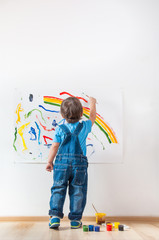Try Playing on a Vertical Surface
by Melissa Engelhardt, SOT
Kids Place West Student Occupational Therapist
Most writing, drawing, coloring, and playing occurs on a tabletop or floor, both horizontal surfaces. While these surfaces are convenient because toys stay in place, they also encourage poor posture. Playing on horizontal surfaces can lead to poor posture from slouching, hunching forward, and limiting arm movement.
Instead, try working on a vertical surface! There are many developmental benefits to writing and working on a vertical surface. By modifying the environment, you change the muscles that are activated in the body. Working on a vertical surface can make activities fun for children and make challenging tasks, like writing, more interesting.
Kids should work on a vertical surface because…
- Writing on a vertical surface improves wrist extension and pencil grasp. Vertical surface writing naturally puts the wrist in an extended position which encourages better pencil grasp and fine motor control of writing utensils. Fine motor skills such as writing and coloring first develop as large movements and become refined to smaller movements. Working on vertical surfaces helps to improve dexterity and control.
- The use of larger vertical surfaces such as chalkboards and whiteboards improves shoulder and elbow stability. It allows children to use bigger arm movements which provide strength and flexibility to joints and muscles of the arms and shoulders.
- Stabilizing the paper to write on an upright surface requires the use of both hands which improves bilateral coordination.
- Sitting at the edge of a chair or removing the chair all together to work in a kneeling or standing position at a vertical surface improves core strength and posture and allows children to engage abdominal and back muscles to maintain upright posture.
- Vertical surfaces improve children’s ability to naturally cross the midline of his/her body because the dominant hand has to reach all of the spaces of the surface.
- Children can also improve visual attention and hand-eye coordination due to the task being closer to the child’s eyes. This helps children who have difficulty maintaining visual attention to activities and also encourages good head and neck position.
- When a child works on a large vertical surface it makes directional terms like up, down, left, and right easier to understand because the child can relate the words to his/her own body. This helps to improve a child’s spatial awareness.
10 Ideas for Play on a Vertical Surface
- Tape a piece of paper to the wall and draw, color, stencil or complete puzzles.
- Grab an easel and draw on the chalkboard or paint with paint brushes or paint rollers.
- Play with magnets on the refrigerator.
- Draw on a whiteboard or chalkboard using dry erase markers or chalk.
- Play with putty or play-doh on the window.
- Wash windows, chalkboard, whiteboards or head outdoors and wash the car.
- Play with shaving cream or finger paint on an easel or mirror.
- Hang paper on the wall and put stickers on the paper.
- Decorate a window with window clings.
- Draw and number dots on a large surface to encourage big movements and crossing midline
Try the activities in different positions like standing, kneeling or sitting on a ball.
When children work on a vertical surface with a big picture, they receive even more benefits including coordination of both sides of the body, core strengthening, and midline crossing.








